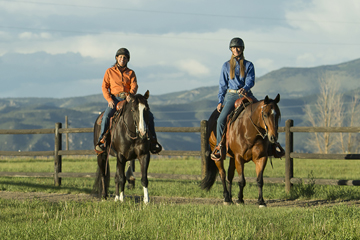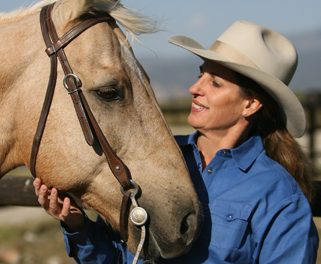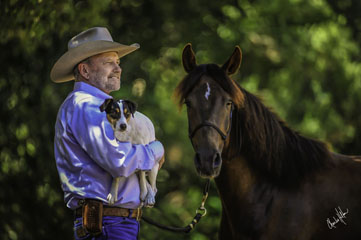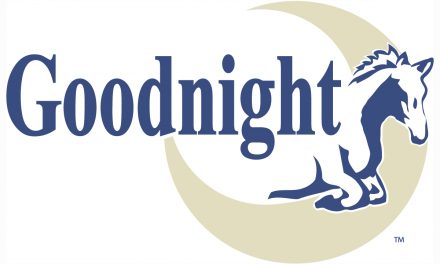Notes From Julie
Dear Julie,
 I purchased your DVD, Lead Line Leadership, and I have been searching your library and need some basic clarification. What is the difference in lead line circling (from Lead Line Leadership) and longeing? What/when is an appropriate use of each and can you please include what is the proper equipment for each?
I purchased your DVD, Lead Line Leadership, and I have been searching your library and need some basic clarification. What is the difference in lead line circling (from Lead Line Leadership) and longeing? What/when is an appropriate use of each and can you please include what is the proper equipment for each?
Answer: Good question! This is a subject I talk about at every groundwork clinic that I do, but I have not written much on the subject. So thanks for asking!
There are actually three kinds of circling work that you might do from the ground with horses—each for different purposes and with different technique and equipment. There’s round pen work, done with the horse at liberty in a confined area, for the purpose of establishing herd hierarchy between you and your horse and getting the horse to “hook on” to you. Then there’s circling work done on a training lead (12-15’ lead line) as is covered in the video you mentioned, for the purposes of refining your relationship and developing a line of communication with the horse. And also, there is longe line work, done on a 25’ or longer light line, primarily for the purpose of exercising or conditioning the horse or for training purposes such as bitting, teaching voice commands or working on transitions, or for performance ends, such as vaulting or longe line obedience competitions.
For round pen work, the equipment needed includes a small area of confinement with a high, sturdy and safe fence to discourage the horse from trying to jump out and to protect his legs if he gets them tangled up in the fence. The purpose of the confinement is to simply level the playing field between you and your horse, so you aren’t chasing him over 40 acres; it doesn’t really have to be round, it’s just easier if it is (otherwise he constantly gets hung up in the corners as you are driving him around). A 60’ pen is ideal for groundwork and allows just enough room to ride the horse at a walk and trot as well. A smaller pen of 50’ makes the circling work easier for you but harder on the horse and it may get a little crowded if the horse cops an attitude (and it’s too small to ride in effectively).
For round pen work, the horse should be at liberty (no halter, lead or bridle) and the handler should have a flag or stick or lariat in hand in order to direct the horse and defend himself if the horse should become aggressive or charge. Ideally the horse should wear protective leg boots, like splint boots or sports medicine boots, to protect the legs in hard turns and accidental collision with the fence. It’s also not a bad idea to wear a helmet when doing ground work with horses since it is not only possible, but likely that the horse will kick out, strike or become defensive.
As demonstrated in detail in my groundwork video called Round Pen Reasoning, the round pen process involves herding the horse, controlling his space and thereby establishing authority over the horse. It is accomplished in five stages: driving the horse away, controlling his direction with outside turns, controlling his speed, changing directions with inside turns and allowing the horse to hook-on to you as his herd leader. Lead line work is also done in part on the circle, driving your horse away from you in a fashion similar to longeing—but for different reasons. With lead line circling, your goal is to refine the relationship with the horse that was begun in the round pen; to not only assert greater authority over the horse, but to establish a line of communication where the horse is focused on you and looking for each and every directive you issue. For lead line circling, you’ll also drive the horse in a circle, control his speed and do lots of changes of direction using subtle gestures. It has nothing to do with exercising or tiring the horse; it has to do entirely with relationship building and communicating—once you get the response you want from the horse, your job is done, regardless how much time it took or how many circles you made.
The ideal equipment for lead line circling is a rope halter and 12-15’ training lead. My halters and leads are specially designed for this type of work, with the halters made of a high-tensile and slightly stiff rope of moderate diameter (the narrower the rope, the harsher the pressure) that does not stretch. My training leads are made with a heavy yacht rope that is pliable and comfortable in your hands and heavy enough to give good feel between you and your horse. I prefer not to have a metal buckle attachment to the halter since it may bruise the horse’s chin if the rope is jerked hard.
The handler should also have a flag or stick to direct the horse and prevent him from coming close enough to kick or strike you. The same protective equipment for you and your horse as outlined for round pen work is well advised. My video, Lead Line Leadership, explains the different exercises you can do on the lead line, including circling work.
Longeing is more simplistic and has more to do with the number or circles your horse makes and the distance he travels. You’ll probably want to use a halter that maximizes the horse’s comfort, like a padded nylon-web or leather halter or a longeing cavesson, with or without a bit in his mouth (depending on your purpose for longeing). A longe line is usually lightweight and 25-30’ long to allow the horse to make the largest circle possible, thereby covering more distance and reducing the stress on his joints. A longe whip is generally used by the longeur to help cue and motivate the horse; it is extra long and has a long lash. Although a horse that is properly trained to longe will respond to visual and audible cues from the longeur, there is not as much dialogue or relationship building between horse and longeur as there is with round pen and lead line work.
With my extensive travel schedule, I don’t get as much ride time on my horse as I’d like and therefore he gets longed each day, simply for the exercise—so he stays in reasonable shape for me to ride when I am home. He is well-mannered and obedient and does not need the ground work for relationship purposes; even if he has not been ridden in a very long time, I would not feel the need to longe him to “get the kinks out,” as many people do. I am not a big believer in longeing for that purpose, because I think it could be an indication that more ground work is needed to bring the horse into a more obedient and compliant frame of mind. Although having excess energy could be a reason for a horse to feel exuberant or energetic, it is not an excuse for disobedience.
There are numerous articles in my training library that relate to the different ground work techniques and specific issues that arise.
Thanks for your astute question—it is always wise to think about why you are doing certain things. The more you understand, the greater the chances for success.
Good luck!
Julie
If you liked this article, Julie suggests the following products to help you continue the work with your horse (http://shopping.juliegoodnight.com or call 800-225-8827 for ordering help): The From the Ground Groundwork DVD Series: http://shopping.juliegoodnight.com/DVDs_c5.htm
Horse Master Air Schedule
SPECIAL NEWS! Watch Horse Master with Julie Goodnight at its new time on RFD-TV! Mondays at 12:30 and 10:30 p.m. EST, Fridays at 6:30 a.m. EST and Saturdays at 10:30 p.m. PST!
All episodes are available on DVD by calling 800-225-8827.
Week of July 25 HM413
Julie Goodnight: “Blowing in the Wind.” On Horse Master: Teaching a trail horse to ride right past scary objects. (2011)
Week of August 1 HM414
Julie Goodnight: “Baby Come Back.” On Horse Master: Teaching a rider precise cues for backing. (2011)
Week of August 8 HM415
Julie Goodnight: “Walk this Way.” On Horse Master: Teaching a rider to extend the walk and speed up on the trail. (2011)
Week of August 15 HM416
Julie Goodnight: “Round and Round.” On Horse Master: Teaching a young horse to respond to body cues in the round pen. (2011)
Week of August 22 HM 417
Julie Goodnight: “Follow the Leader.” On Horse Master: Teaching the horse to follow & turn toward you in the roundpen. (2011)
Week of August 29 HM 418
Julie Goodnight: “Fresh Grounds” Teaching a horse to relax and not bolt at new show grounds.(2011)
Week of September 5 HM 419
Julie Goodnight: “U Turn” Teaching rollbacks. (2011)
Find more free articles to read and refer to in Julie’s Training Library: http://juliegoodnight.com/q&a.php and watch Horse Master on RFD-TV every Monday at 12:30 and 10:30p EST —Direct TV channel 345, Dish Network channel 231 and on many cable outlets. Then visit http://www.horsemaster.tv and http://www.juliegoodnight.com/clinics for the clinic schedule, articles related to each episode, the gear used in each show, and for training DVDs and publications.
Plus, see clips from each show at: http://www.horsemaster.juliegoodnight.com and check out specials and even more clips on Goodnight’s Facebook Fan Page: http://www.facebook.com/horsemaster.tv.
Sign up for the free monthly newsletter at: http://juliegoodnight.com/emailsignup.php.
Goodnight is proud to recommend Myler Bits, Nutramax Laboratories, Circle Y Saddles, Redmond Equine, and Spalding Fly Predators.
Goodnight is the spokesperson for the Certified Horsemanship Association.





